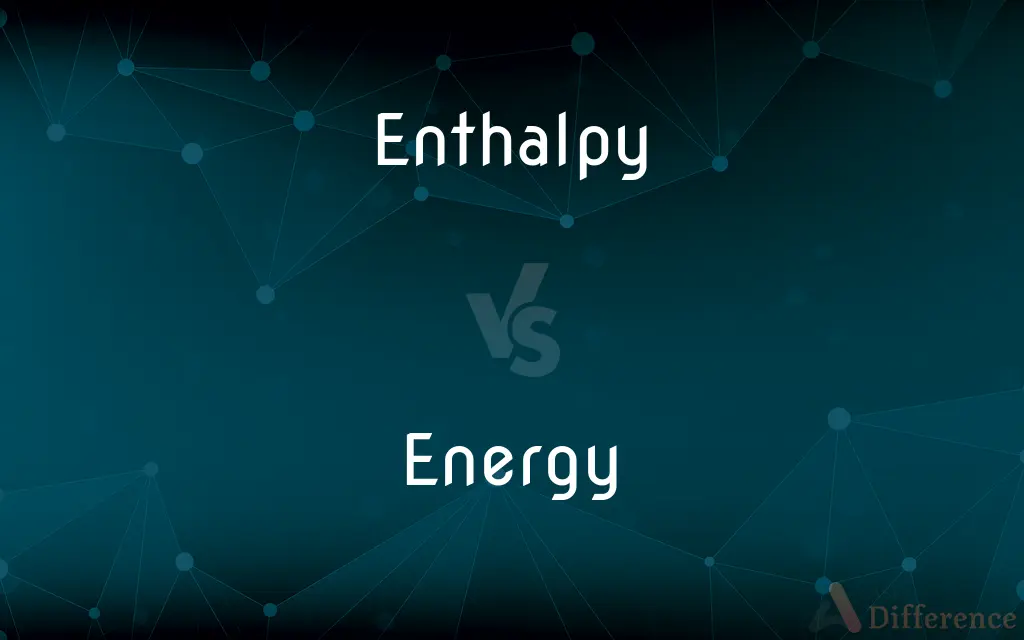Enthalpy vs. Energy — What's the Difference?
By Tayyaba Rehman & Maham Liaqat — Updated on March 25, 2024
Enthalpy is a measure of total heat content in a system, while energy encompasses various forms including kinetic and potential.

Difference Between Enthalpy and Energy
Table of Contents
ADVERTISEMENT
Key Differences
Enthalpy, represented as H, is a thermodynamic quantity equivalent to the total heat content of a system. It is used to quantify the energy needed for a system to create products at constant pressure. On the other hand, energy is a more encompassing term that describes the capacity to do work or produce heat, including various forms such as kinetic, potential, thermal, and chemical energy.
The concept of enthalpy is particularly useful in processes occurring at constant pressure, where it helps in understanding heat changes. Energy, in its broader sense, applies to a wide range of phenomena, not just thermodynamic processes, and includes the total kinetic and potential energies of a system.
Enthalpy changes, denoted as ΔH, are crucial for understanding reactions in chemistry, especially in the context of heat absorption or release. Energy changes, however, encompass not only heat but also work done by or on the system, reflecting a more comprehensive view of system dynamics.
In the context of a chemical reaction, enthalpy helps in determining whether a reaction is endothermic (absorbs heat) or exothermic (releases heat) at constant pressure. Conversely, the total energy consideration might include changes in both heat and work, offering a broader perspective on the reaction's energetics.
While enthalpy is a useful concept for understanding heat changes in chemical and physical processes, energy, as a broader term, encompasses all forms of energy changes, including mechanical work and heat, across all kinds of physical, chemical, and biological systems.
ADVERTISEMENT
Comparison Chart
Definition
Measure of total heat content in a system at constant pressure.
Capacity to do work or produce heat, encompassing various forms.
SymbolH
Often denoted as E or
U for internal energy.
Key Usage
Heat changes in chemical/physical processes at constant pressure.
Broad application across all energy changes, including work and heat.
Measurement Units
Joules (J)
Joules (J)
Relation
Subset of system's energy related to heat.
Encompasses all forms including kinetic, potential, and thermal.
Compare with Definitions
Enthalpy
Total heat content of a system at constant pressure.
The enthalpy change during a chemical reaction indicates heat absorbed or released.
Energy
Exists in various forms, including mechanical, electrical, and chemical.
Electrical energy powers devices, while chemical energy is stored in bonds between atoms.
Enthalpy
Standard enthalpy changes provide benchmarks for reactions.
The standard enthalpy of formation is a reference for comparing the energy required to form compounds from their elements.
Energy
Fundamental to understanding physical laws and processes.
The concept of energy is central to the laws of physics, governing phenomena from atomic to cosmic scales.
Enthalpy
Measured as the system's internal energy plus the product of its pressure and volume.
Enthalpy (H) is calculated as H=U+PV, where U is internal energy, P is pressure, and V is volume.
Energy
Conserved in isolated systems according to the first law of thermodynamics.
In a closed system, the total energy remains constant, showcasing energy conservation.
Enthalpy
Often used in the context of thermodynamic cycles and state functions.
In a steam turbine, the enthalpy drop of steam correlates with the turbine's energy output.
Energy
Broad concept encompassing the capacity to do work or produce heat.
Kinetic energy of moving objects or potential energy due to position.
Enthalpy
Crucial for understanding endothermic and exothermic processes.
An endothermic reaction has a positive enthalpy change, indicating heat absorption.
Energy
Transfers between systems can occur as work or heat.
Energy transfer in an engine occurs as heat is converted to mechanical work.
Enthalpy
Enthalpy (listen) is a property of a thermodynamic system, and is defined as the sum of the system's internal energy and the product of its pressure and volume. It is a state function used in many measurements in chemical, biological, and physical systems at a constant pressure, that is conveniently provided by the large ambient atmosphere.
Energy
In physics, energy is the quantitative property that must be transferred to a body or physical system to perform work on the body, or to heat it. Energy is a conserved quantity; the law of conservation of energy states that energy can be converted in form, but not created or destroyed.
Enthalpy
Symbol H A thermodynamic function of a system, equivalent to the sum of the internal energy of the system plus the product of its volume multiplied by the pressure exerted on it by its surroundings.
Energy
The capacity for work or vigorous activity
Who has the energy to climb that trail?.
Enthalpy
A measure of the heat content of a chemical or physical system.
, where H is enthalpy, U is internal energy, p is pressure, and V is volume.
Energy
Also energies Exertion of vigor or power
A project requiring a great deal of time and energy.
Devoted her energies to writing songs.
Enthalpy
(thermodynamics) a thermodynamic quantity equal to the internal energy of a system plus the product of its volume and pressure;
Enthalpy is the amount of energy in a system capable of doing mechanical work
Energy
Vitality and intensity of expression
A speech delivered with energy and emotion.
Energy
(Informal) A nonphysical force or quality perceived as inhering in a particular place, person, or situation
Was turned off by the group's negative energy.
Energy
Usable heat or power
Each year Americans consume a high percentage of the world's energy.
Energy
A source of usable power, such as petroleum or coal.
Energy
The capacity of a physical system to do work.
Energy
A form, amount, or level of this capacity
"a searing beam of 30 trillion protons, with energies up to 50 million electronvolts" (Science News).
Energy
The impetus behind all motion and all activity.
Energy
The capacity to do work.
Energy
(physics) A quantity that denotes the ability to do work and is measured in a unit dimensioned in mass × distance²/time² (ML²/T²) or the equivalent.
Energy
An intangible, modifiable force (often characterized as either 'positive' or 'negative') believed in some New Age religions to emanate from a person, place or thing and which is (or can be) preserved and transferred in human interactions; shared mood or group habit; a vibe, a feeling, an impression. aura.}}
Energy
The external actions and influences resulting from an entity’s internal nature (ousia) and by which it is made manifest, as opposed to that internal nature itself; the aspect of an entity that can affect the wider world and be apprehended by other beings.
Energy
A measure of how many actions a player or unit can take; in the fantasy genre often called magic points or mana.
Action points
Energy
Internal or inherent power; capacity of acting, operating, or producing an effect, whether exerted or not; as, men possessing energies may suffer them to lie inactive.
The great energies of nature are known to us only by their effects.
Energy
Power efficiently and forcibly exerted; vigorous or effectual operation; as, the energy of a magistrate.
Energy
Strength of expression; force of utterance; power to impress the mind and arouse the feelings; life; spirit; - said of speech, language, words, style; as, a style full of energy.
Energy
Capacity for performing work.
Energy
(physics) the capacity of a physical system to do work; the units of energy are joules or ergs;
Energy can take a wide variety of forms
Energy
An exertion of force;
He plays tennis with great energy
Energy
Enterprising or ambitious drive;
Europeans often laugh at American energy
Energy
An imaginative lively style (especially style of writing);
His writing conveys great energy
Energy
A healthy capacity for vigorous activity;
Jogging works off my excess energy
He seemed full of vim and vigor
Energy
The federal department responsible for maintaining a national energy policy of the United States; created in 1977
Common Curiosities
How do enthalpy and energy relate to thermodynamics?
Both concepts are foundational in thermodynamics, with enthalpy concerning heat changes at constant pressure and energy encompassing all forms of work and heat.
Why is enthalpy important in chemistry?
Enthalpy changes indicate whether a chemical reaction absorbs or releases heat, crucial for understanding reaction energetics.
Can energy change in a closed system?
In a closed system, energy can transform between forms but the total energy remains constant, adhering to conservation laws.
How is enthalpy calculated?
Enthalpy is calculated as the internal energy of a system plus the product of its pressure and volume (H=U+PV).
Can energy be converted completely from one form to another?
While energy can transform between forms, factors like inefficiency and entropy prevent complete conversion.
What is enthalpy?
Enthalpy is the total heat content of a system at constant pressure, reflecting its internal energy and the work needed to make space for it.
How does energy differ from enthalpy?
Energy is a broader term describing the capacity to do work or produce heat, while enthalpy specifically measures heat content under constant pressure.
What signifies a positive enthalpy change?
A positive enthalpy change signifies an endothermic process, where the system absorbs heat from its surroundings.
What units are used to measure enthalpy and energy?
Both enthalpy and energy are measured in Joules (J) in the International System of Units (SI).
Is kinetic energy a form of energy considered in enthalpy?
While kinetic energy is a form of energy, enthalpy specifically relates to heat content and doesn't directly account for kinetic energy.
How does enthalpy relate to exothermic reactions?
In exothermic reactions, enthalpy decreases as the system releases heat, often marked by a negative enthalpy change.
What role does enthalpy play in biological systems?
Enthalpy changes in metabolic reactions indicate energy storage or release, essential for organism functioning.
How do phase changes affect enthalpy?
Phase changes, like melting or vaporization, involve significant enthalpy changes due to the heat absorbed or released.
What is the first law of thermodynamics?
It states that energy cannot be created or destroyed, only transformed or transferred, underscoring energy conservation.
How do engineers use the concept of energy?
Engineers apply energy principles to design efficient systems, from engines to electrical circuits, optimizing energy use and conversion.
Share Your Discovery

Previous Comparison
Cone vs. Prism
Next Comparison
Hole vs. OrificeAuthor Spotlight
Written by
Tayyaba RehmanTayyaba Rehman is a distinguished writer, currently serving as a primary contributor to askdifference.com. As a researcher in semantics and etymology, Tayyaba's passion for the complexity of languages and their distinctions has found a perfect home on the platform. Tayyaba delves into the intricacies of language, distinguishing between commonly confused words and phrases, thereby providing clarity for readers worldwide.
Co-written by
Maham Liaqat













































